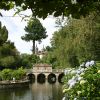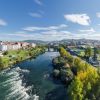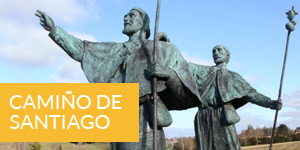- Accede I
- Regístrate I
- carrito
Pazos y jardines históricos
Duración: 1/2 día
Itinerario: Pazo de Ribadulla - Pazo de Oca - Ponte Gundián
Descripción: En las proximidades de Santiago se encuentran los antiguos Pazos de Santa Cruz de Ribadulla y de Oca, cuyos jardines, históricos e artísticos, figuran entre los más destacables de España. La excursión discurre por la comarca que riega el río Ulla, tierra de gran interés por su paisaje, vegetación y antiguos monumentos. En San Xoán da Cova está Ponte Gundián, puente-icono de toda la comarca, una antigua obra de ingeniería por la que todavía sigue pasando el tren. Domina el paisaje el Pico Sacro, la cima más bella y simbólica de Galicia, con restos medievales, digno de una visita.
excursiones de ½ día
Paradas recomendadas
Pazo de Ribadulla-Pazo de Oca-Ponte Gundián
En las cercanías de Santiago se encuentran los bellísimos y celebrados pazos -'palacios'- de Santa Cruz de Ribadulla y de Oca, cuyos jardines, históricos y artísticos, figuran entre los más destacables de toda España.
La excursión discurre por la comarca que riega el río Ulla, cuyo paisaje, vegetación y antiguos monumentos hacen de ella una región de altísimo interés, que por su relación con Santiago, debe ser considerada como el jardín y huerto de la ciudad.
El valle, de formas variadas de meandros hundidos, altos acantilados, se viste de densa y profunda vegetación de pinares, y de grandes robledas que alternan con viñas, que producen mostos suaves y dorados, praderías y maizales, y no hay aldea en esta región que no luzca algún bello pazo, alguna iglesia bien labrada. El río, de bellas aguas, por su caudal el segundo de Galicia, es rico en truchas, salmones y, en su tramo final, lampreas.
Domina el paisaje que recorre la excursión la silueta del Pico Sacro, la cumbre más bella y simbólica de Galicia, visible en la composición de extensos horizontes. Sus entrañas son de cuarzo -posee la primera sima de cuarzo natural del mundo- y en su cumbre se encuentra la ermita de hermosos arcos y capiteles románicos de San Sebastián (no visitable). El Pico, lugar mítico, conocido ya en la antigüedad latina, fue escenario de la evangelización por el Apóstol, quien, con sólo la señal de la Cruz, hizo caer inútil al tremendo dragón que lo habitaba, símbolo de la paganía. Fue además, según la leyenda, el lugar donde los discípulos del Apóstol Santiago amansaron dos toros bravos para que trasladaran el cuerpo del Apóstol al lugar sobre el que hoy se levanta la Catedral.
En el Pico hubo castillos dominadores; amenazó y defendió a Santiago, pero la historia guerrera cede ante la belleza y el horizonte. En los días claros se puede vislumbrar desde allí el conjunto de los grandes edificios de Compostela, agrupados en torno a las torres basilicales, el valle del río Ulla, e incluso el mar de la ría de Arousa, en la que aquel desemboca.
Pazo de Santa Cruz de Ribadulla y Pazo de Oca
Los pazos son viviendas de arquitectura noble típicas de la Galicia rural, que tuvieron su máximo esplendor entre los siglos XVII y XIX. Entre ellos destacan los dos que se incluyen durante este itinerario: el Pazo de Santa Cruz de Ribadulla, también llamado de Ortigueira, y el Pazo de Oca, ambos en las inmediaciones de Santiago de Compostela.
Suelen enlazarse con los castillos, presentándolos como una derivación propia de tiempos menos guerreros. Sin embargo, el estilo genuino de los pazos debe más a la arquitectura campesina y monástica que a la militar de las fortalezas. Las torres son no sólo decorativas, sino necesarias para tomar el sol y contemplar el paisaje. La solana se abre al patio para vigilancia y como peusto de honor. Muchas veces la fiesta popular se celebra en el patio a donde da la capilla, y la solana es el palco de invitados de calidad. En la decoración predomina lo barroco. Transportado a las ciudades, sabe ordenarse en rúas y conserva mucho de su estilo sin que se confunda con la arquitectura estrictamente burguesa ni aún con las casas nobles derivadas de antiguas casas fuertes de la ciudad.
Aunque los interiores de estas dos edificaciones no son visitables, si lo son sus estupendos jardines, auténticos monumentos de la naturaleza que destacan pos la variedad y porte de sus especies y por su paisajismo. Ambos cuentan con una parte ajardinada, otra de bosque y las tierra de labor. Las diferencias entre los jardines de ambos se refieren a la concepción original, más voluptuosa, espectacular y selvática en el de Ribadulla, siguiendo los parámetros del jardín de tipo inglés, más cuidada, decorativa y coqueta en el de Oca, que tiene un diseño más elaborado que juega con la piedra y el agua.
Donde más poderosa y variada se muestra la vegetación es en el jardín del pazo de Santa Cruz de Ribadulla. Carballeiras -'robledales'- gallegas, venerables olivos, viven secularmente al lado de magnolios y eucaliptus, y son de una belleza real y melancólica las avenidas de mirtos trepados por líquenes blancos y grises. Y además está habitado, y eso le transmite la calidez de los monumentos vivos, y comercializa camelios muy codiciados entre los mayoristas floristeros.
En Oca, las torres decorativas y el jardín de mirtos, rosas y laberintos, conservan la gracia incomparable del XVIII. Un magnífico acueducto, labrado y decorado, alimenta estanques dignos de una villa cardenalicia, y los viejos castaños forman avenidas.
Los pazos gallegos se han hecho tema literario, sobre todo a partir de las novelas gallegas de la señora Pardo Bazán y de Valle Inclán (Los pazos de Ulloa, Cuentos, Bucólica, La Sirena Negra, Sonata de Otoño, Romance de Lobos, Águila de blasón).
Viaducto de San Xoán da Cova (Ponte Gundián)
El surco del valle es bien visible desde el desde el estrechamiento de San Xoán da Cova, en Ponte-Ulla, cruzado por el espectacular viaducto del tren, que preside todo el paisaje: Ponte Gundián, icono de toda la comarca.
En el estrecho de San Xoán da Cova vivió anidado entre los formidables peñascos de la margen derecha sobre el río, el cenobio de ese nombre, habitado desde el siglo IX por ermitaños de la regla de Santo Agostiño. En febrero de 1571 una excepcional avenida del río derrumbó el cenobio, que no volvió a edificarse.
Fervenza do Toxa
Hermoso espectáculo de agua, luz y sonido, formado por unha cascada de agua del río Toxa entre las parroquias de Pazos y Martixe (Silleda), considerada la más alta de Galicia en caída libre. Constituye un espacio de gran valor paisajístico. En sus proximidades nos encontramos con el Monasterio de Carboeiro, edificio de especial relevancia dentro del románico gallego.



















